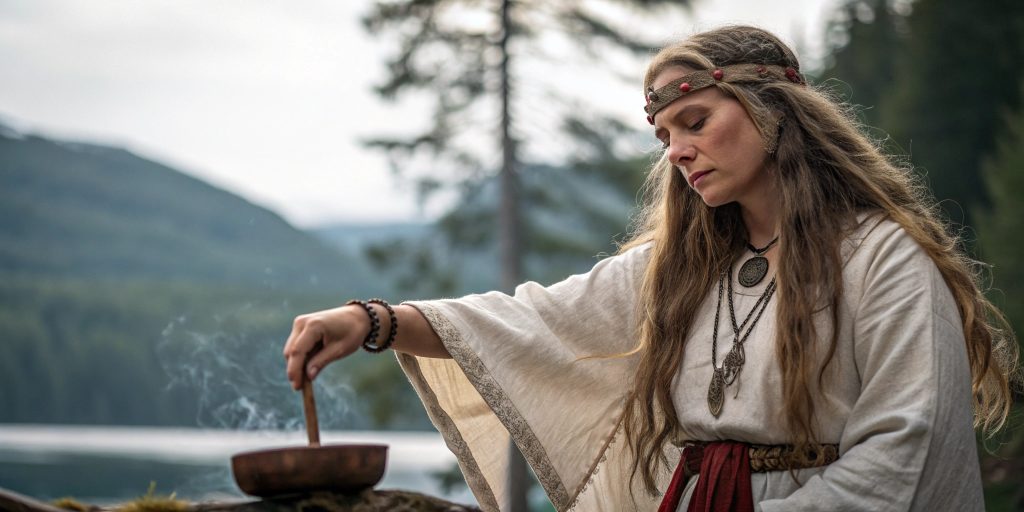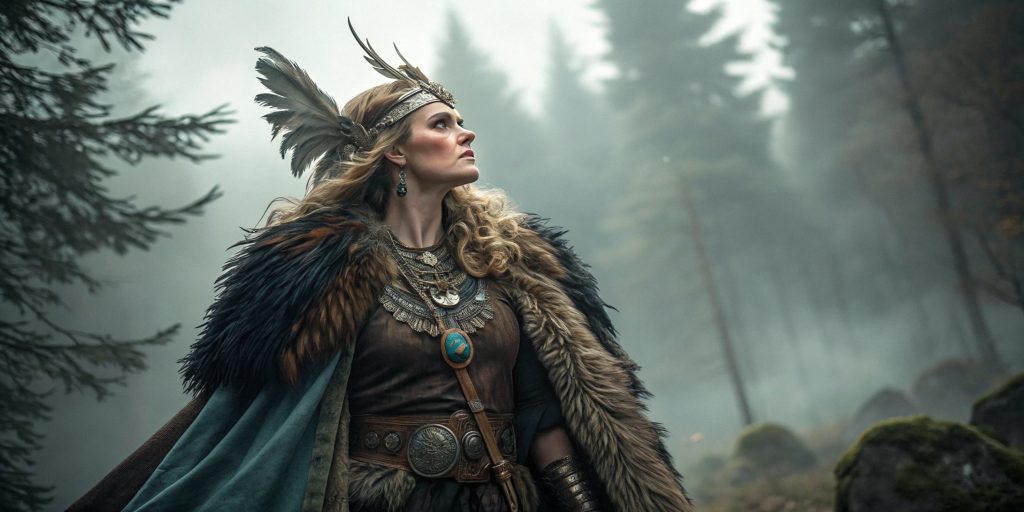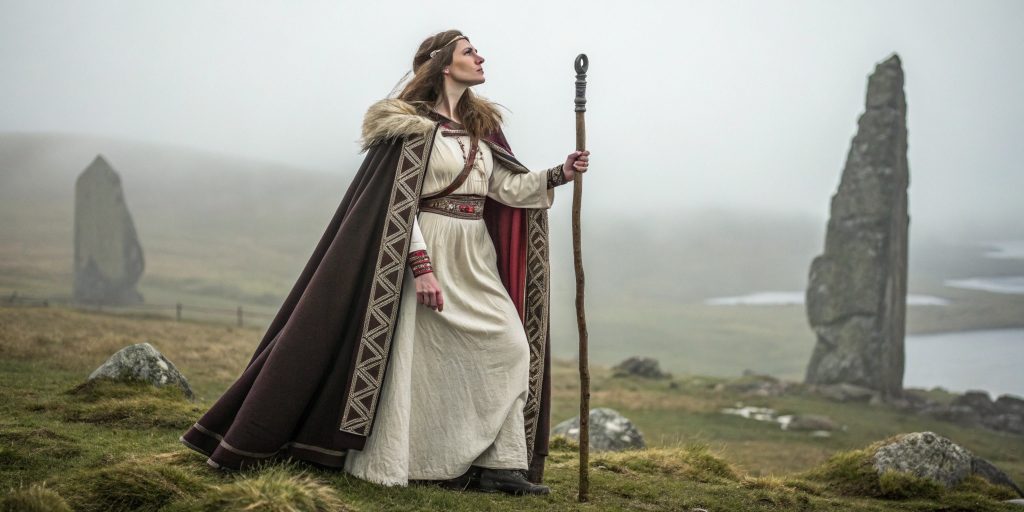Freya, Norse Goddesses, Norse Mythology, Norse Runes, Vanir Goddesses, Vikings
What Does Seiðkona Mean?
The term seiðkona means “woman of seiðr.” It shows her deep connection to Norse culture. Seiðr is a special kind of magic tied to Freyja, the goddess of divination and healing.
To understand seiðkona’s meaning, we must examine her role in the Viking Age. Her magic touched personal lives and community beliefs, showing the power of magic and spiritual practices.
The Origins of Seiðkona
The seiðkona’s story begins in the Viking Age, a time filled with culture and magic in Norse society. She was seen as a link between the world we know and the mystical.
Her magic was both loved and feared. Knowing her history helps us see her importance in social and spiritual life.
Historical Context in Norse Culture
In Norse culture, the seiðkona was special. Women who practiced seiðr were known as sorceresses and keepers of knowledge. They played key roles in rituals, divination, and making big decisions.
They were called upon in hard times, which showed their value. Yet, some were wary of them, while others respected their powers, which shows mixed feelings about them.
Language and Etymology
The word seiðkona tells us a lot. It comes from “seiðr” (magic) and “kona” (woman). This shows what these women were seen as in their community.
They were seen as both mystical and feminine. This highlights their important role in Viking Age society, linking magic, gender, and community.
Seiðkona Meaning
Exploring the seiðkona’s meaning shows a rich tapestry in Old Norse traditions. It’s not just about Norse magic; it also links to femininity and spiritual power. To get its whole meaning, we must look at its parts.
Understanding the Term in Old Norse
“Seiðkona” comes from “seiðr,” meaning magic, and “kona,” which means woman or wife. This shows women’s special role in Norse magic. In Old Norse, a seiðkona was a powerful woman who connected with the unseen world.
This shows women’s sacred power in ancient times. The term paints a picture of a woman who practices magic. It shows how gender and spirituality meet in Norse culture.
Roles and Responsibilities of a Seiðkona
Seiðkonas were key in Norse communities. They acted as a bridge between the physical and spiritual worlds. They used their skills for divination, healing, and guidance.
Their work touched many parts of life. This showed how important they were in Norse rituals.
Magic and Divination Practices

Seiðkonas were experts in many divination methods. They used different techniques to uncover secrets. This included:
- Prophetic readings to predict the future.
- Healing rituals to cure physical or spiritual sicknesses.
- Talking to ancestral spirits for wisdom.
These practices showed the deep bond between seiðkonas and their communities. They offered help and insight during hard times, and their skills were highly respected, making them important figures.
Connection to the Vanir and Æsir
Seiðkonas were closely tied to the Vanir and Æsir, two main groups of gods. The Æsir stood for order and rule. The Vanir were linked to fertility, wealth, and the mysterious.
This connection made seiðkonas’ work richer. They honored these gods through rituals. This helped keep their communities in balance.
Being connected to the Vanir and Æsir showed their magical abilities. It also highlighted their role in keeping harmony in Norse religion.
Seiðr: The Practice of Seiðkona
Seiðr has a deep connection to Norse magic. It’s a mix of ancient rituals and practices, each with its purpose and way of working.
Types of Seiðr
There are many kinds of seiðr in Norse culture. Each one has its role in magic. Here are a few:
- Healing Seiðr: This type helps with physical and spiritual healing. It uses herbs and divine help.
- Divination Seiðr: It’s for telling the future. Practitioners go into a trance to get answers.
- Protective Seiðr: This keeps bad energies away. It uses special symbols and charms.
- Fertility Seiðr: It’s for growing and abundance. It makes offerings to gods of growth.
Rituals Associated with Seiðr
Seiðr rituals are full of tradition. They connect us to Norse spirituality. They happen in unique places.
- Staffs and Rods: These tools help focus energy.
- Runes: They carry deep meanings. Often used in rituals.
- Offerings: Gifts to gods and spirits. Show respect in Norse magic.
- Ceremonial Garments: These clothes show the practitioner’s role. They connect to magic.
Seiðr is a big part of Norse magic. It shows a strong spiritual tradition and practice.
The Cultural Significance of Seiðkona
The role of seiðkona was vital in Norse society because of their link to the goddess Freyja. Freyja was known for love, fertility, and war, making her a potent symbol for women who practiced magic.
Her connection to seiðr showed the value of female magic users and the complex relationship between magic and being female.
Freyja and the Female Practitioners of Magic
Freyja was at the center of seiðr practices. Her combination of sensuality and power made seiðkonas in the community follow her example.
Women who practiced magic used Freyja’s qualities, which gave them power in a society ruled by men. Freyja’s respect helped female magic users gain some authority.

The Intersection of Gender and Magic
The mix of gender and magic in Norse society reveals a lot about social norms. Seiðkonas’ practices often went against traditional gender roles, showing how women could have power through magic.
This struggle between society’s rules and magical power shows the complexity of femininity in Norse culture. It helps us see how seiðr was more than just divination and healing. It was also a way for women to resist gender roles.
Seiðkona in Norse Mythology
The role of seiðkona in Norse mythology is filled with stories and figures. These people have special powers that connect them to the spiritual world. They are known for their deep understanding of magic, especially Freyja.
Mythological Figures and Legends
In Norse myths, seiðkona is associated with many figures, each with its powers. They play a big role in stories, affecting both gods and humans. They help predict the future and shape families’ destinies.
Comparative Analysis with Völva and Spákona
We see their unique roles when we compare seiðkona with Völva and spákona. Völva is known for seeing the future through visions. Spákona, on the other hand, uses magic to predict what will happen. These differences show their importance in Norse myths and our understanding of magic.
The Seiðkona’s Tools and Symbols
In Norse practices, the seiðkona used many tools and symbols. Each was chosen for its special meaning. It helped her channel energies and set intentions during rituals. Knowing about these tools gives us a peek into ancient traditions.
Common Items Used in Rituals
Some key items for the seiðkona include:
- Distaff: It stands for weaving fate, showing the feminine side of creation.
- Staff: It acts as a power channel, guiding energies in spells and rituals.
- Offerings: Food, herbs, or crafts are given to honor spirits and gods.
- Altar: A sacred area for items, making the ritual space more spiritual.
The Role of Runes in Seiðkona Practices
Runes are mighty in seiðkona magic. They are not just letters but carry deep meanings and energies. The seiðkona would use runes to improve divination and spell casting.
Using these tools and symbols in rituals honors Norse traditions and helps us better understand ancient spiritual practices.
Modern Interpretations of Seiðkona
Norse magic has sparked a deep interest in old traditions, especially contemporary paganism. Today, people mix old magic with new spiritual ways, showing how old beliefs still speak to us.
The Revival of Norse Practices
Norse traditions are coming back strong in paganism today. Many find inspiration in the stories of seiðkona. They want to connect with the past and show their spiritual sides. The revival includes:
- Exploring old texts and ways.
- Mixing traditional seiðr with today’s spirituality.
- Hosting events for Norse traditions.
Seiðkona in Contemporary Paganism
Seiðkona practices are loved and celebrated in paganism today. People use seiðr to deal with today’s challenges. This includes:
- Workshops on traditional seiðr.
- Online groups are talking about seiðkona.
- Art inspired by seiðr.
As we see seiðkona in new ways, it helps bring back Norse traditions. It shows a big interest in old spiritual practices and today’s needs. This mix of old and new opens up new paths for understanding paganism.
The Impact of Seiðkona on Norse Religion
The seiðkona is a crucial figure in Norse religion. Over time, she has shaped many aspects of Norse spirituality. Her magical practices have influenced both personal beliefs and community rituals.
Influence on Norse Spirituality
The seiðkona played a significant role in Norse spirituality. She introduced magic and divination into religious life, and by talking to the gods and gaining secret knowledge, she made spirituality deeper for followers.
Her influence is seen in many ways:
- She made women important spiritual leaders, raising their status in the Norse religion.
- She added seiðr to group rituals, bringing people together.
- She helped keep stories of Norse myths and legends alive.
Today, the seiðkona’s legacy lives on in Norse spirituality. Her practices still inspire new rituals and beliefs. This shows how deeply she has influenced Nordic religious identity.
Conclusion
The seiðkona played a key role in Norse culture. She was a master of magic and divination, and her work showed how important gender roles were then.
It also showed a deep connection between spirituality and nature. By studying the seiðkona, we learn about Viking beliefs and customs.
In Norse myths, the seiðkona was seen as wise, powerful, and feminine. Her legacy still inspires today’s spiritual practices, which use old traditions.
By looking at the seiðkona, we see the depth of Norse spiritual practices. Her impact reminds us of the beliefs of the old. It shows how these beliefs are still important today.

